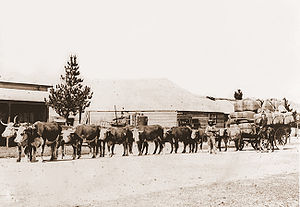
Back Werkdier Afrikaans Arbejdsdyr Danish Ζώο εργασίας Greek Tööloom Estonian جانوران کار Persian חיית עבודה HE Hewan pekerja ID Anụ na-arụ ọrụ IG 使役動物 Japanese 사역동물 Korean

A working animal is an animal, usually domesticated, that is kept by humans and trained to perform tasks instead of being slaughtered to harvest animal products. Some are used for their physical strength (e.g. oxen and draft horses) or for transportation (e.g. riding horses and camels), while others are service animals trained to execute certain specialized tasks (e.g. hunting and guide dogs, messenger pigeons, and fishing cormorants). They may also be used for milking or herding. Some, at the end of their working lives, may also be used for meat or leather.
The history of working animals may predate agriculture as dogs were used by hunter-gatherer ancestors; around the world, millions of animals work in relationship with their owners. Domesticated species are often bred for different uses and conditions, especially horses and working dogs. Working animals are usually raised on farms, though some are still captured from the wild, such as dolphins and some Asian elephants.

People have found uses for a wide variety of abilities in animals, and even industrialized societies use many animals for work. People use the strength of horses, elephants, and oxen to pull carts and move loads. Police forces use dogs for finding illegal substances and assisting in apprehending wanted persons, others use dogs to find game or search for missing or trapped people. People use various animals—camels, donkeys, horses, dogs, etc.—for transport, either for riding or to pull wagons and sleds. Other animals, including dogs and monkeys, help disabled people.
On rare occasions, wild animals are not only tamed, but trained to perform work—though often solely for novelty or entertainment, as such animals tend to lack the trustworthiness and mild temper of true domesticated working animals. Conversely, not all domesticated animals are working animals. For example, while cats may catch mice, it is an instinctive behavior, not one that can be trained by human intervention. Other domesticated animals, such as sheep or rabbits, may have agricultural uses for meat, hides and wool, but are not suitable for work. Finally, small domestic pets, such as most small birds (other than certain types of pigeon) are generally incapable of performing work other than providing companionship.